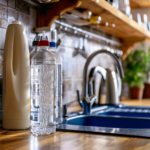In this article, we will guide you through the process of installing under-cabinet lighting, an essential addition to any well-designed kitchen or workspace. With a focus on professionalism, we will provide step-by-step instructions, ensuring you have the necessary tools and materials, preparing your cabinets for installation, wiring and connecting the lights, and testing the functionality of the lighting fixtures. By following our expert advice, you will be able to enhance both the functionality and aesthetics of your space.
Assessing Your Lighting Needs
Before proceeding with any under-cabinet lighting installation, it is crucial to accurately assess your lighting needs, so that you can make informed decisions about the type and placement of fixtures. Evaluating options and determining a budget are two key aspects of this assessment process.
When evaluating options for under-cabinet lighting, consider the different types available, such as LED strip lights, puck lights, or linear fixtures. Each type has its own advantages and disadvantages in terms of brightness, energy efficiency, and ease of installation. Additionally, think about the color temperature that best suits your needs, whether it’s warm white, cool white, or daylight.
Determining a budget is another important factor in assessing your lighting needs. Consider your overall budget for the project, including the cost of purchasing fixtures, any additional wiring or electrical work required, and the cost of hiring a professional if needed. It’s important to strike a balance between quality and affordability, ensuring that you get the best value for your money.
Choosing the Right Under-Cabinet Lighting
When it comes to choosing the right under-cabinet lighting, there are several factors to consider. First, you need to decide on the type of lighting that suits your needs, such as LED, fluorescent, or halogen. Additionally, you should take into account the installation considerations, including power source, wiring, and mounting options.
Types of Lighting
Exploring the various options available, selecting the appropriate type of lighting for under-cabinet installation is crucial for achieving optimal illumination in the kitchen workspace. When considering under-cabinet lighting, it is essential to understand the different types of lighting available, including task lighting and ambient lighting. Task lighting is focused lighting that provides direct illumination to specific areas where tasks, such as chopping vegetables or reading recipes, are performed. It is typically bright and concentrated, ensuring visibility and reducing eye strain. On the other hand, ambient lighting is more general and provides overall illumination to the kitchen space. It creates a warm and inviting atmosphere while also enhancing the visibility of the entire area. By combining both task lighting and ambient lighting, homeowners can create a well-lit and functional kitchen workspace.
Installation Considerations
During the installation process, it is important to carefully consider factors such as the electrical requirements, mounting options, and placement of under-cabinet lighting to ensure optimal functionality and aesthetic appeal. When it comes to the installation process, it is crucial to follow the manufacturer’s instructions and safety guidelines. Before starting, make sure to turn off the power to the area where the lights will be installed. Additionally, it is important to choose the right type of under-cabinet lighting for your needs, whether it be LED strips, puck lights, or linear fixtures. Troubleshooting tips include checking for loose connections, testing the power supply, and replacing any faulty parts. By taking the time to plan and execute the installation process correctly, you can enjoy the benefits of under-cabinet lighting in your space.
Gathering the Necessary Tools and Materials
To successfully install under-cabinet lighting, it is essential to gather all the required tools and materials beforehand. Before beginning the installation process, it is important to ensure that you have all the necessary supplies. This includes the lighting fixtures, wiring, connectors, screws, and a power source. Additionally, it is crucial to measure the space where the lighting will be installed. This will help you determine the length and number of lighting fixtures needed. Accurate measurements will ensure a seamless installation and prevent any issues with spacing or fitting. Gathering the supplies and measuring the space in advance will save time and frustration during the installation process. It is always better to be prepared and have everything you need before starting any project.
Preparing Your Cabinets for Installation
Before installing under-cabinet lighting, it is important to properly prepare your cabinets. This includes ensuring the cabinet surfaces are clean and free from any debris or residue that could affect the installation. Additionally, you will need to plan the wiring and electrical connections, as well as determine the best method for mounting the light fixtures onto the cabinets.
Cabinet Surface Preparation
The proper cleaning and sanding of the cabinet surfaces is crucial for achieving a smooth and durable finish during the installation process. Cabinet cleaning is an essential step in preparing the cabinets for installation. Before beginning the cleaning process, it is important to remove any hardware or accessories from the cabinets. This will ensure that the cleaning solution can penetrate the surface and remove any dirt or grime. Surface protection is another key aspect of cabinet cleaning. Using a mild detergent and a soft cloth, gently clean the cabinet surfaces, paying close attention to any areas that may have accumulated grease or stains. Once the cabinets are clean, sanding the surfaces will help to create a smooth and even finish. By following these steps, you can ensure that your cabinets are properly cleaned and prepared for installation.
Wiring and Electrical Connections
Using proper techniques and materials, ensure that all wiring and electrical connections are secure and meet safety standards. When installing under-cabinet lighting, it is crucial to follow wiring techniques that prioritize electrical safety. This involves carefully planning the layout and placement of the lighting fixtures, ensuring that no wires are exposed or at risk of damage. All connections should be securely fastened to prevent any loose or exposed wiring, which can be a potential fire hazard. It is also important to use appropriate wiring materials that are suitable for the electrical load and environment. This includes using insulated wires and connectors that are designed for the specific voltage and amperage requirements of the lighting fixtures. By following these guidelines, you can ensure a safe and reliable installation of under-cabinet lighting in your kitchen or workspace.
Mounting the Light Fixtures
Once all wiring and electrical connections are secure, it is important to carefully mount the light fixtures onto the prepared cabinets. Properly positioning fixtures ensures optimal lighting for the workspace. Begin by determining the desired location for each fixture, taking into account the size and shape of the cabinet. Use a pencil to mark the spots where the fixtures will be mounted. Next, secure brackets onto the cabinet using screws or adhesive, ensuring they are level and sturdy. The brackets provide a stable base for the fixtures to attach to. Finally, carefully attach the fixtures onto the secured brackets, ensuring they are firmly in place. Take care not to overtighten the screws to avoid damaging the fixtures or the cabinets. By following these steps, you can successfully mount the light fixtures for your under-cabinet lighting installation.
Installing the Under-Cabinet Lighting Fixtures
Before beginning the installation process, it is important to ensure that all necessary tools and materials are readily available for properly installing the under-cabinet lighting fixtures. Installing under-cabinet lighting can enhance the functionality and aesthetics of your kitchen or workspace. To successfully install these fixtures, it is essential to familiarize yourself with the installing techniques and troubleshooting tips. Firstly, make sure to measure and mark the desired location for the fixtures. Use a level to ensure they are aligned correctly. Secondly, follow the manufacturer’s instructions for wiring and connecting the fixtures. It is crucial to turn off the power supply before working with any electrical components. Lastly, troubleshoot any issues by checking the connections, replacing faulty components, or consulting a professional if necessary. By following these techniques and troubleshooting tips, you can easily install under-cabinet lighting fixtures and enjoy a well-lit space.
Wiring and Connecting the Lights
One must carefully follow the manufacturer’s instructions to ensure proper wiring and connection of the lights, as it plays a crucial role in the successful installation of under-cabinet lighting. When it comes to wiring techniques for under-cabinet lighting, it is important to consider safety and functionality. Firstly, ensure that the power source is turned off before starting any wiring work. Next, carefully strip the wires and connect them securely using wire connectors or terminal blocks. It is also important to properly ground the lighting fixtures to prevent electrical shocks. Additionally, it is recommended to use UL-listed wiring and connectors for added safety. By following these proper wiring techniques, you can ensure a seamless installation of under-cabinet lighting fixtures that not only enhance the aesthetics of your space but also provide functional task lighting.
Testing and Adjusting the Lighting
It is essential to thoroughly test and adjust the lighting fixtures to ensure optimal brightness and proper illumination levels in the under-cabinet area. Testing methods play a crucial role in identifying any issues and ensuring that the lighting system functions as intended. One common testing method is to turn on the lights and observe if they provide sufficient illumination without any flickering or dimming. Additionally, a light meter can be used to measure the light levels and compare them to recommended standards. Troubleshooting tips can help address any issues that may arise during the testing process. These may include checking the power source, examining the wiring connections, and ensuring that the fixtures are securely attached. Regular testing and adjustment of the lighting fixtures will help maintain a well-lit and functional under-cabinet area.




